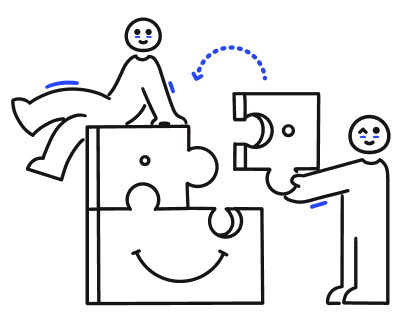As a manager, you want to build a high-performing team. But generally, teams don’t perform at a high level straight out of the gate. Usually, they have to go through some growing pains to figure out how to work together (and how to work well together) — also known as the storming phase.
The storming phase is a normal part of team development, but it can be challenging. Let’s take a look at how you can support your team through the storming phase, so they come out of the storm a stronger, more effective, and more cohesive unit.
From flawed to flawless: 5 steps to leading distributed teams

What's in this article
What is the storming phase?
The storming phase is the second of the four stages of team development, a concept by psychologist Bruce Tuckman that outlines how teams grow and develop.
Tuckman’s stages of team development:
Forming stage
The forming phase is when the team is initially coming together. Group members are excited to get started, but aren’t super clear on what the team will be doing, how they’ll work together, or how they as an individual fit into the big picture.
Storming stage
The storming phase is when things get…well, a little stormy with the new team (we’ll dive deeper into this stage momentarily).
Norming stage
The norming phase is when the team really starts to come together. This is the stage where team members get more comfortable working together and have a better understanding of the team’s goals and direction.
Performing stage
At the performing phase, the team is a cohesive unit that understands how to collaborate to hit goals. The team is performing at its highest level.
While the four stages of development are typically used to describe newly-formed teams, they also apply to more established teams. For example, when a team goes through major changes, they may go from the performing stage back to the storming stage. So understanding how to navigate the storming stage is a must, whether you’re managing a new or established team.
Why does the storming phase happen?
There are a few different reasons the storming phase happens, including:
The team is still building trust.
Trust is a key element in high performing teams. But when you first bring a group together (or when their established norms get shaken up), a foundation of trust hasn’t had time to develop. That lack of trust can lead to conflicts and challenges.
Employees are still figuring out how to work well together.
People work differently; they have different work styles, different ways of collaborating, and different ideas about the way things should (or shouldn’t) be done. It takes time for teams to get on the same page about how to work well together. And until they do, the team dynamics can be a bit challenging.
You’re still figuring out the best way to manage them.
Just like it takes time for your group members to figure out the best way to work together, it takes time for you to figure out the best way to manage them. There’s always some trial and error in figuring out what management style works best for your team.
What happens during the storming phase?
During the storming phase, your team has had some time to get to know each other and start working collaboratively. Overall, the team is past the “getting to know you” jitters. They’re feeling more comfortable sharing their opinions — and challenging the opinions of their fellow team members. Things are moving forward. But as their work has ramped up, they’ve bumped into inevitable challenges, delays, bottlenecks, and conflicts.
Signs your team is in the storming phase:
- Increased frustration
- Increasing complaints from team members
- Decreased productivity
- Disengagement from work
- Interpersonal conflict between team members
- Lack of respect towards management/leadership
Real-world example: Picture this
You put together a new team to spearhead a marketing pitch. At first, everyone is excited to work together, assemble the pitch, and land a new client. But after a few weeks, things start to change. Team members disagree on everything from which ideas to pitch to how to design and organize marketing assets.
People are frustrated, both with each other and with leadership. Individual team members are pulling you aside to complain about the work, the project, and their co-workers. Things aren’t getting done — and every day, it seems like the team is more frustrated and less engaged.
All the challenges, frustrations, and setbacks the team (and you) are facing? They’re clear indicators the team is in the storming phase.
How do I get through the storming phase?
The storming phase is a normal part of team formation, but that doesn’t mean it’s not tough, both for you and your employees. As a manager, you want to be the one to bring the solutions and get everyone working together. But a big part of getting through the storm is getting your team to sort things out among themselves.
Here are a few strategies to help you better navigate the storming phase and lead your team through this time of growth and change.
1. Focus on building trust
How you build trust will depend on the team. Some teams will appreciate you trusting them to do their jobs how they see fit. Others will develop trust more quickly and easily when you set clear expectations and provide structure and oversight. Some employees will build trust by throwing themselves into partnering on projects. Others will prefer to ease into collaborative work slowly to get a better feel for their new teammates.
The point is, building trust is a crucial part of getting through the storming phase. But to effectively build that trust, you need to…
2. Get to know your team members (and help them get to know each other)
Getting to know individual team members gives you the insights you need to foster trust, and structure your team in a way that empowers their best work. Spend time getting to know your new team members.
Find out things like:
- What are their personality types?
- What are their goals, for themselves and for the team?
- How do they do their best work?
- What work styles do they find frustrating?
- Do they prefer having structure and direction, or more autonomy?
When you know and understand people on a more personal level, you’ll manage the team more effectively.
For example: After getting to know your team, you may identify a potential personality clash between two employees. With that information, you can structure the team in a way that minimizes collaboration with those two team members — and minimize team conflict as a result.
As important as it is to get to know your team members, it’s just as important for them to get to know each other. Make sure you’re carving out time for team building activities, social interactions, and 1-on-1 collaboration opportunities to help build trust within the team.
3. Create a team culture of honesty and transparency
When you create a team culture that values honesty and transparency, you create a sense of psychological safety for your team. That sense of safety makes people feel comfortable speaking openly and honestly, helping to build trust and push the team through the storming phase.
For example: If employees feel like they can give you direct feedback on what's not working, you can work to fix those things. Even better, you can get team members to work collaboratively with you towards solutions.
So, how do you create a culture of honesty and transparency? It starts with you. If you’re open, honest, and transparent with your team, it gives them permission to do the same. Be as candid as possible when discussing issues with your employees. Ask for feedback, and make sure they know it’s valued (even if it’s hard to hear). Address issues and conflict immediately and directly (instead of aggressively or passive aggressively), and encourage your team to do the same.
4. Continually work on better collaboration
These strategies will help you move your team through the storming phase. But getting your team to the performing stage isn’t a one-time accomplishment. To keep your team performing at a high level, have them continually reflect on what’s working and what’s not working. Support your team in using those insights to improve and encourage better team collaboration.
Check in frequently with your team, both individually and as a team. Retrospective meetings are a great opportunity for everyone to work together to make improvements. It’s also important for you to touch base individually with employees in one-on-one meetings. They might share things they don’t feel comfortable sharing in a group setting.
Ask questions like:
- How is the team working well together?
- Where are they struggling?
- Are there any systems or processes you can change to better support them?
Out of the storm, and into performance
The storming phase can be hard on teams. But now that you know how to better navigate the storming phase, you have everything you need to effectively navigate the storm — and emerge on the other side as a stronger team.



